Introduction
Although the export share of British sports cars going to the USA was much bigger than those heading for continental Europe, Lucas acknowledged in the early 50’s the necessity to come with an improved, highly efficient light unit for (fast) driving on the (European) continent. Lucas opted for “vertical dipping” making use of British Pre Focus (BPF) bulbs.
Given the formidable British racing successes in Le Mans, the PR department of Lucas decided that this headlamp series would be called “Le Mans 24”. Although some sources indicate that these head lamps had been specially developed by Lucas for racing at Le Mans, this is factually incorrect. The assignment for the Lucas development group was much more complicated because Lucas management wanted a very efficient head lamp system that could fulfil the legal requirements for road use in different (continental) European countries and that could be formally approved for those countries. Remember this was far before any form of European cooperation and legal requirements differed per country, often based on national laws that had been developed per country in “splendid isolation”.
The legal requirements for headlamps in the USA were totally different (and partially still are today): the “Le Mans 24” lamp was never intended to become an alternative for the USA. We will not enter here into a formal comparison of the legal requirements for the various continents and countries. We will however emphasis the requirements in some European countries that later formally approved the “Le Mans 24” headlamps, often in combination with the initial type approval of a car for that particular country.
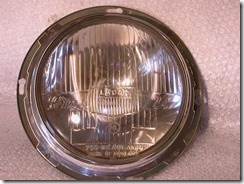 Lucas “Le Mans 24” for XK 140
Lucas “Le Mans 24” for XK 140
Jaguar was a technological forerunner in general and the first company to introduce the “Lucas Le Mans 24” on a production car, destined for Continental Europe: the Jaguar Mk VII carried the Le Mans 24 headlamp unit with Lucas type number 51472A and 51478A from 1952 onwards.
Vertical dipping
Traditionally European manufacturers created a main and dipped beam from a single bulb by introducing two filaments along the axis of the (parabolic) reflector. The high beam filament is always in the focal point of the reflector whereas the dipped beam filament is somewhat “out of focus”: in most cases about 10 mm to the front and 3 mm above the axis. European (continental, thus excluding Great Britain) legal requirements include a sharp cut-off beam pattern which is normally secured by a (cup-shaped) shield below the dipped beam filament which prevents that light would be reflected above the horizon. The bulb has a fixed position in the headlamp securing that the shield is always in the correct place below the filament. There are also other versions than vertical dipping available like RH and LH dipping, but they will not be discussed here.
Also note that in 1956 most continental European countries (again excluding GB) agreed to a new beam pattern in which the beam at the RH (or “passenger side”) of the light unit has been lifted 15 degrees: the typical arrangement that later became the EU standard and basically is still valid today. The Lucas “Le Mans 24” light unit does not fulfil this 1956 standard as its beam pattern has a (very sharp) cut-off over the entire width of the beam. Fortunately in most EU countries the legal requirements have been made in such a way that headlamp requirements contain a mandatory element for the sharp cut-off aspects, with the later (1956) addition that if there is a 15 degree lifted part in the beam, this has to fulfil a number of specific requirements. This implies that in most EU countries that had the sharp cut-off dipped beam pattern standardized before 1956, the “Le Mans 24” light unit would/should be accepted when offered for initial type approval or periodical testing.
Different types of Le Mans 24 light units
The most common version of the Le Mans 24 light unit is Lucas part number 554665 for use with BPF bulbs with lamp base P22d36.
Lucas BPF bulb 350 and 370 with base P22d36 French 3 pin bulb with base BA21d branded Marchall
France was a completely different case with their legal requirement of April 1937 to have yellow headlights in combination with a 3 pin lamp with base BA21d. This was a 36/45W bulb with a 40 mm globe-shaped yellow glass envelope. This bulb type was not manufactured by Lucas (nor by their UK bulb suppliers). Instead Lucas offered an adaptor/bulb holder Lucas part number 562303 to accept BA21d bulbs.
Lucas bulb holder for BA21d Lucas “Shell Adaptor” with bulbholder positioned
From about 1954 Lucas offered a 3 pin BA21d version of the “Le Mans 24” light unit intended for France. The first introduced version was a light unit with Lucas part number 554615. This has not been used by Jaguar (but Aston Martin and Bristol did use this version for Export to France in 1954). This first light unit was succeeded by a second version Lucas part number 555288 which was used by Jaguar for Export to France.
Both the 554615 and 555288 light unit have a larger opening at the back of the reflector (over 40 mm in diameter because of the 40 mm globe-shaped glass of the French bulb) whereas the BPF has an opening of about 22 mm. This French system uses a “Shell adaptor” (Lucas 552943) which is a ring to close the gap between the larger reflector opening and the smaller outer diameter of Lucas bulb holder 562303. The Shell adaptor 552943 was delivered complete with Bulb holder 562303 (as in the above picture).
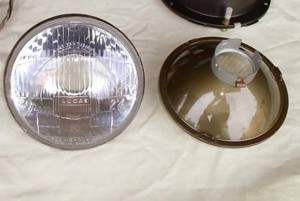 Lucas PF700EF light unit; part number 554288
Lucas PF700EF light unit; part number 554288
The French Bulb holder and Shell adaptor combination also had to compensate the lamp centre length difference of the BPF and the 3 pin BA21d bulbs (LCL: distance from centre of filament to bulb base).
Survey of “Le Mans 24” light units
So resuming we have three different light units, all branded “Le Mans 24”:
- Lucas part number 554615 using 3 pin BA21d bulb for France
This is a special reflector unit with a different mounting of the bulb (adaptor) using two clips (in stead of the bajonet fitting of the other Le mans 24 reflector units). The front glass had a special mark reading “Agréée AB-TP No 457” placed in a dashed rectangle. This is a French homologation mark for approved headlights fulfilling the French requirements as laid down in 1930. The bulb was not provided by Lucas but had to be placed by the Jaguar agent in France (see hereafter).
Back of light unit 254615 Lucas Le Mans 24 unit for France with homologation mark
- Lucas part number 554665 using BPF bulb for Europe (excl. GB and France)
This unit is closely related to the PF700 versions for the British Pre Focus bulbs and also used the same bulb holder, basically Lucas Bulb holder 556402 with suitable wiring (as assembly: Lucas 858543).
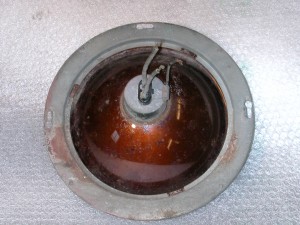 Back of “Le Mans 24” reflector Lucas 554665
Back of “Le Mans 24” reflector Lucas 554665
- Lucas part number 555288 using 3 pin BA21d bulb for France
This light unit is related to the Lucas J-700 unit (with different lens of course), using the same bulb holder Lucas 554855 and Shell adaptor 554909.
 Back of “Le Mans 24” reflector Lucas 555288
Back of “Le Mans 24” reflector Lucas 555288
All these light units share the same glass front lens with part number Lucas 554 359 moulded in the glass in a vertical direction just to the right the centre prisms.
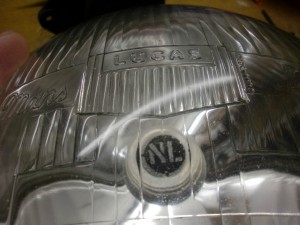 Part number for front lens moulded in glass
Part number for front lens moulded in glass
Manufacturing over the years
Initial production started probably somewhere in 1953 and continued until mid 1960’s. Light units from the initial production can be recognized by the fact that the factory identification is shown in the form of the letters M5 at the bottom of the lens and the NL mark in a circle etched just below the centre. The factory indication (M5) was followed by a date code consisting of one or two letters. I’ve found the following codes on my Le Mans 24 light units: M5 X, M5 AA, M5 CD. Other sources also indicate M5 XX as a date code.
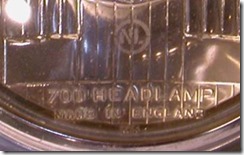 Original 50’s and 60’s production
Original 50’s and 60’s production
Lucas remanufactured the “Le Mans 24” headlamps around 1976, however without the text “700 HEADLAMP”, the factory indication (M5) and the NL mark. We will later see why the NL mark was no longer required.
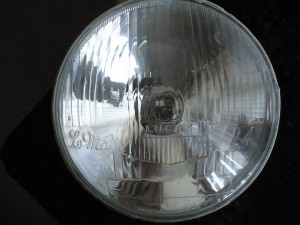 Later (1976) Lucas production
Later (1976) Lucas production
Some small companies have made replicas in more recent years, like the excellent versions manufactured by VHR (Peter Appleyard) of Sheffield (UK).
Since a couple of years replicas have been produced in larger quantities and of a somewhat lower quality: the “Le Mans” and “Lucas” lettering as well as the font of the part number of the front lens is not an exact copy of the original. In addition the “NL” mark is no longer etched but moulded (raised) in the glass which makes it very easy to recognise a reproduction lamp. In addition they tend to form a thin white layer on the inside of the glass lens due to vaporization of the kit used during manufacturing, which apparently has not sufficiently cured (a well known problem in headlamp manufacturing). Prices are rather attractive compared to originals.
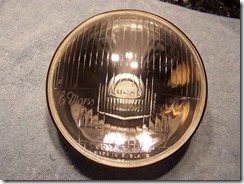 Modern replica
Modern replica
More importantly, the beam patterns of these modern replicas are not of the quality of the original Lucas beam patterns as can be seen in the pictures below. The picture on the left shows a well defined beam with a good horizontal cut-off line, the result of using the original Lucas Le Mans 24 headlamp and a good quality bulb. The pitcure on the left is an example of the beam pattern of a Repro Le Mans 24 headlamp using a good bulb. The pattern is rather “undefined” and the horizontal cut-off is far from perfect.
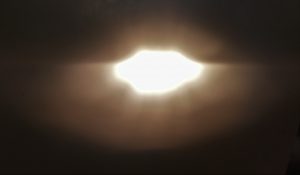
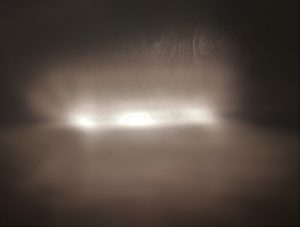 Original Lucas Le Mans 24 beam pattern Reproduction Le Mans 24 beam pattern
Original Lucas Le Mans 24 beam pattern Reproduction Le Mans 24 beam pattern
Survey of Jaguars using “Le Mans 24” headlights
Many jaguars in the period 1953 to 1960 destined for a number of continental European countries had the “Le Mans 24” headlamp although the actual types differ somewhat per car. The survey below shows the “Le Mans 24” types used for the XK types as well.
 Click to open table
Click to open table
We mentioned already that there was no standardization of vehicle lighting (yet) in Europe. This is also the reason why different bulb types are used for different countries on the continent, also driven by the (interest of) national lighting industries like Osram (Germany), Philips (Holland) and Mazda, Philips and Marchal (all in France), not forgetting the British lamp industry in their attempt to keep the BPF bulb alive.
Norway, Sweden and Germany had national requirements stating that the maximum power (per filament) of the bulb should not exceed 35 Watt. This is the reason why the “Le Mans 24” versions destined for these three countries used Lucas bulb 350 (other reference: Philips 12721).
Switzerland and Holland (or better The Netherlands) allowed a two-filament bulb with 45 and 40 Watt power, meaning for these countries Lucas bulb 370 (other reference: Philips 12741) was used.
As mentioned before, France was a completely different case with their 1937 legal requirement to have yellow headlights in combination with a 3 pin BA21d 36/45W yellow bulb (reference Philips 12736 Y). Lucas provided dedicated “Le Mans 24” light units for this, initially coded 554615 and later 555288.
XK 120 with “Le Mans 24” headlamps
Note: XK 120’s normally had the PF770 headlamps whereas the Le Mans 24 headlamp belongs to the PF700 group. The Le Mans 24 headlamps had the same outer chrome rim although the light unit was of course smaller. This was solved by using a different “light unit retaining plate”. See the complete survey under chapter “Le Mans 24” Headlight fixation systems and parts.
XK 120 (1952/1954) for Norway, Sweden and Germany
Not specified by Jaguar for the XK 120, but following the information provided in various Lucas catalogues these cars may (could) have been executed from 1952 onwards with Lucas 51478A (Jaguar part number unknown) using the “Le Mans 24” light unit 554665 whereby the standard bulb Lucas 370 has been replaced by bulb Lucas 350 which is a BPF P22d36 lamp with 35W/35W filaments.
XK 120 (1952-1954) for Switzerland and Holland
According the Lucas 400D & E catalogue (but not mentioned in the Jaguar SPC) these cars had the same Lucas 51478A unit (Jaguar part number unknown) installed, using the Le Mans 24 light unit 554665 in combination with bulb Lucas 370 which is a BPF P22d/36 lamp with 45W/40W filaments.
Late XK 120 (1953-1954) for France: no “Le Mans 24” units
The Lucas “Le Mans 24” light unit was not yet available for the French market. Modified PF770 versions were still used for France with initially Lucas part number 50840/A and later 50780/A; both used Lucas light unit 553961. Also reference is made of Lucas 51194B which was a later replacement version for all “French” version for the XK 120 1949-1954, however with a different light unit (Lucas 553948).
XK 140 with “Le Mans 24” headlamps
XK 140 for Norway, Sweden and Germany
These cars had Lucas 51564A/B (Jaguar part number C5626) installed, using the “Le Mans 24” light unit 554665 in combination with bulb Lucas 350 which is a BPF P22d36 lamp with 35W/35W filaments.
XK 140 for Switzerland and Holland
These cars had Lucas 51565A/B (Jaguar part number C5625) installed, using the “Le Mans 24” light unit 554665 in combination with bulb Lucas 370 which is a BPF P22d36 lamp with 45W/40W filaments.
XK 140 for France
Special version for France only with Lucas 51563A/B (Jaguar part number C5627) installed, using the “Le Mans 24” light unit 555288 and no bulb was provided by Lucas. Lucas provided bulb adaptor 562303 (intended for the BA21d 3 pin base) in combination with Shell adaptor 554909 with the head lamp unit. It is assumed that the French Jaguar importer Delecroix (or even a local Jaguar dealer) installed a 3 pin yellow 36/45W filament bulb. We assume that this bulb was manufactured by various French bulb manufacturers (like e.g. Norma, Mazda and Philips) and was branded Marchall with code Granilux 12V 36 / 45 W and approval number Agréée ABTP 288.
XK 150 with “Le Mans 24” headlamps
XK 150 for Norway, Sweden and Germany
These cars continued the use of Lucas 51564A/B (see XK 140).
XK 150 for Switzerland and Holland
These cars continued the use of Lucas 51565A/B (see XK 140). Note: this headlamp is now indicated by Jaguar as F700 whereas the same item is indicated as PF700 for the XK 150 for Norway, Sweden and Germany; it may be assumed that this is an omission as also the Lucas catalogue still uses the PF700 description.
XK 150 for France
These cars continued the use of Lucas 51563A/B (see XK 140). Note: the french headlamp for the XK 150 is now indicated as F700EF, whereas the same item is indicated as PF700EF for the XK 140; it may be assumed that this is an omission as also the Lucas catalogue still uses PF700. Also to be noted that Lucas used the code EF for their entire product portfolio as an abbreviation for “Export France”.
XK-SS with Le Mans 24 headlamps
The XK-SS destined for the USA in 1958 received the Lucas “Le Mans 24” light unit but in this case without the typical large chrome rims as used on the XK’s. This headlamp was of the (P)F700LR (Long Range) type with code number 51766B/E which assembly made use of the 554665 light unit and the 370 (45/40W) bulb. This description in fact refers to the “Switzerland and Holland” specification; versions for Norway, Sweden and Germany could be obtained by changing the bulb for the Lucas 350 type. No indication exist for a possible Export France version.
“Le Mans 24” headlight fixation systems and parts
To understand the evolution of the “Le Mans 24” fixation over the different generations of Jaguars, we have to know the way the older PF770 headlamp systems were mounted.
PF770 Headlamp fixation till March/April 1950
The fixation of early PF770 headlamps (with the “inward flange” headlamp bowls/domes/ buckets) was different from all later versions. The horizontal beam adjustment was done with a LH and RH bracket attached to the Fixation ring and two screws fixed to the Retainer rim. The screws were placed in a radial direction (see pictures below). The vertical adjustment screw (at the top of the light unit) was placed in the direction of the lamp axis (like all later adjustment systems. The fixing ring had a riveted tapped plate for the screw and a short compression spring.
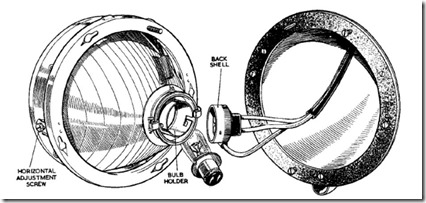 Early PF770 system
Early PF770 system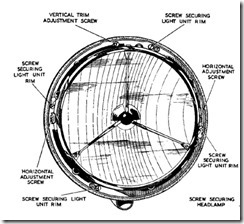
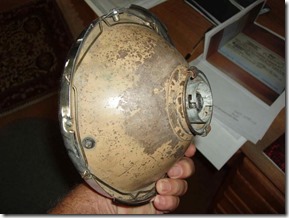
This system (on basis of the headlamp bowl/dome/bucket with the inward flange; see photo below), used the following parts (for the XK 120):
- Fixation ring Jaguar 3450 or Lucas 552704, complete with two brackets for horizontal adjustment of light unit
- Retaining rim Jaguar 3430 or Lucas 552686, no ears for fixation but a wire spring was used instead; two tapped holes for the (horizontal) adjustment screw
- Wire spring Jaguar 3441 or Lucas 552687
Note that the headlamps for 7 inch USA & Canada Sealed Beam light units had a different Fixation/Retaining ring Jaguar 3450 (Lucas 553614) with a different inner diameter to match the smaller light unit size.
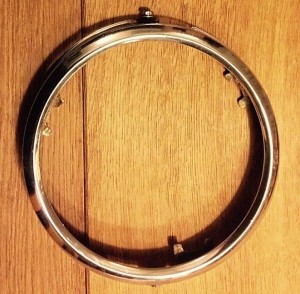 Lucas 554596 Retaining Ring Sealed Beam unit (early/late PF770)
Lucas 554596 Retaining Ring Sealed Beam unit (early/late PF770)
PF770 Headlamp fixation from March/April 1950 onwards
The headlamp bowl/dome/bucket had now changed to Lucas PF770 Mk II with an outward flange, which also changed the fixation method of the light unit itself: screws were used now instead of the wire spring:
- Fixation ring Lucas 553877; zinc plated
- Retaining rim Lucas 553878 with 7¼” aperture; fixation with 4 “ears” and screws
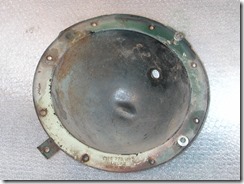
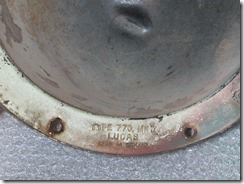 PF770 Mk II
PF770 Mk II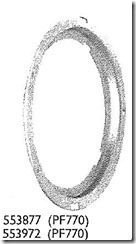
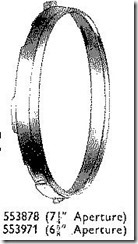 Fixation ring 553877 and Retaining rim 553878
Fixation ring 553877 and Retaining rim 553878
“Le Mans 24” headlamps on Jaguar Mk VII from 1953 onwards
The Lucas parts catalogue refers to the following parts for “Le Mans 24” light units first installed on a Jaguar Mk VII in 1953. None of these (post 1950) PF770 parts have been continued on the later “Le Mans 24” applications. The Jaguar Mk VII with “Le Mans 24” headlights was the first to change over to the 3 screw adjuster system.
- Fixation ring Lucas 553972; zinc plated, looking identical to to the original (later) PF770 ring Lucas 553877 but modified to accept a 7” light unit. The adjustment screw has a longer compression spring in a spot welded socket which is tapped at the bottom for the screw.
- Retainer rim Lucas 553971; chromed, now suitable for 7” light units, with a 6⅝” aperture; otherwise identical to the original PF770 Mk II rim Lucas 553878 with 4 “ears” and screws
Note that the Jaguar Mk VII by 1953 had already the (late)r PF770 Mk II headlamp bowl/dome/bucket with the outward flange, requiring a different fixation ring than the pre March/April 1950 types; installing “Le Mans 24” headlamps on earlier Mk VII versions may therefore not be feasible.
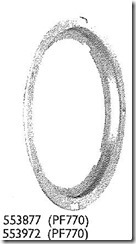
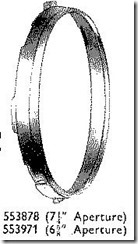 Fixation ring 553972 and Retaining rim 553971
Fixation ring 553972 and Retaining rim 553971
“Le Mans 24” headlamps on Jaguar XK 120 from 1953 onwards
Jaguar XK 120 versions (1953 onwards) equipped with “Le Mans 24” light units (Lucas 554665) used a mix of existing and new different parts. The XK 120 with “Le Mans 24” headlamps continued the old horizontal headlamp adjustment system.
- Fixation Ring (Jaguar 3450; Lucas 553614; zinc plated); this ring is also used for the USA & Canada 7” sealed beam headlamps and has two “ears” for horizontal bean adjustment and also acting as pivot for vertical adjustment (with two screws positioned horizontal) .
- Retainer Rim (Lucas 554596; chromed); probably a modified version (with a 6⅝” aperture) of the standard (later) XK 120 Retainer rim Lucas 553878 (with 7¼” aperture).
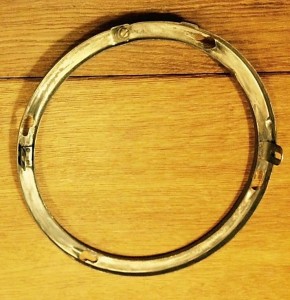
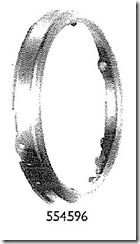 Fixation ring 553614 and Retaining rim 554596
Fixation ring 553614 and Retaining rim 554596
“Le Mans 24” headlamps on Jaguar XK 140 and 150
The XK 140 and 150 continued the use of the Lucas back shell/dome/bucket PF770 Mk II version. Remember that this is intended for 7.7” headlamps, whereas the Lucas “Le Mans 24” is a 7” light unit. With the introduction of the XK140 & 150 Jaguar changed over to the J700 concept: a 7” light unit. But also the USA and Canada versions (Lucas 51562) had a 7” light unit (although of the Sealed Beam type). The “Le Mans 24” light units (Lucas 554665) shared the same parts with the J700 and the 7” Sealed Beam versions. So XK 140s and 150s from the USA can receive “Le Mans 24” headlights, which is an advantage when these cars are brought to Norway, Sweden, Germany, Holland and Switzerland. Unfortunately the “Le mans 24” light unit is not allowed in the USA itself.
- Fixation Ring Jaguar 5302 and Lucas 554906 (zinc plated)
- Retainer Rim Jaguar 5301 and Lucas 554907 (chromed); 4 “ears” for fixation.
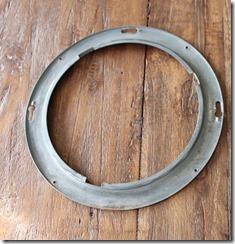
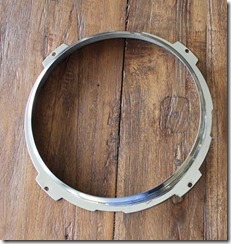 Fixation ring 554906 Retaining rim 554907
Fixation ring 554906 Retaining rim 554907
“Le Mans 24” headlamps on Jaguar XK-SS (USA only)
This headlamp was of the (P)F700LR (Long Range) type with code number Lucas 51766B/E. It consisted of the following fixation parts:
- Fixation Ring Lucas 554672 ; zinc plated with 6 slots (instead of normally 3)
- Retainer Rim Lucas 554893 ; chromed. Also used for other F700 applications.
“Le Mans 24” headlamps on Jaguar Mk1 and Mk2
For addiional information the Jaguar Mk1 and Mk2 applications of the “Le Mans 24” are also presented here. In general we observe that Jaguar had definitely closed the PF770 (Mk II) era and now adopted the Lucas F700 range of components for their headlights.
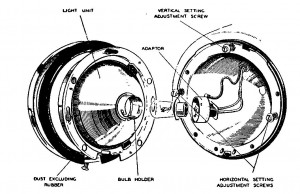 Typical (P)F700 arrangement om Mk1 & Mk2
Typical (P)F700 arrangement om Mk1 & Mk2
These parts have been widely used on many British cars of the 60s: Austin, MG (Midget and B), Rover, Triumph, Morris, Mini and Austin-Healey. Spare parts should be easy to obtain.
- Fixation Ring Lucas 554782 (zinc plated)
- Retainer Rim Lucas 554781 (chromed); 3 “ears” for fixation.
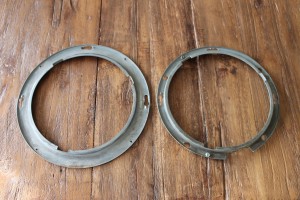
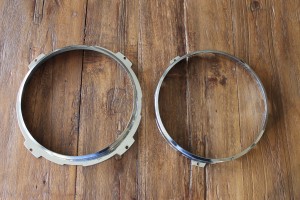 Note difference in size between XK140/150 rings (left on both photos) and Mk1/Mk2 versions
Note difference in size between XK140/150 rings (left on both photos) and Mk1/Mk2 versions
Approval marks for (continental) Europe or “The myth of the NL mark”
As mentioned above, various European countries (except GB) required a headlamp that fulfilled all legal requirements regarding the “sharp cut-off” of the dipped beam in combination with a high light output, that could not be fulfilled with the existing Lucas headlamps with BPF bulbs. With the introduction of the “Le Mans 24” light unit this became feasible and three versions were made each aiming at the requirements of a group of countries (or a single country in the case of France):
- Norway, Sweden and Germany with light unit 554665 and bulb 350 (35/35 W)
- Switzerland and the Netherlands with light unit 554665 and bulb 370 (45/45 W)
- France with initially light unit 554615 and later with light unit 555288 in combination with a 3 pin yellow bulb 36/45W.
Per January 1st, 1954 a new law had been introduced in the Netherlands that all lighting (and bulbs) of all vehicles on the road should have a “state approval mark” in order to increase road safety. The requirements had been laid down in this law and testing requirements had been assigned to (and consequently drafted by) the Dutch electrical testing Institute KEMA. The “state approval mark” should be clearly visible on the relevant part. From that moment onwards all approved vehicle lighting (from bicycle rear-lamps to car headlamps) carried the NL mark. The “Le Mans 24” light unit was no exception and the manufacturer was obliged to put the NL approval mark on their product.
 NL approval mark etched on front lens “Le Mans 24”
NL approval mark etched on front lens “Le Mans 24”
All stories about NL meaning “not legal” or “near left” are incorrect: it merely was a type approval for the Dutch market required to sell Jaguars in Holland. There are various examples of other Lucas light units that showed this NL mark on the lens.
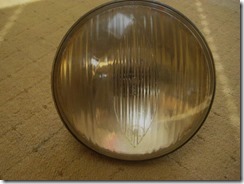 NL mark on light unit 552402 or 553759 for S700 headlamps
NL mark on light unit 552402 or 553759 for S700 headlamps
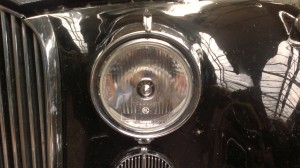
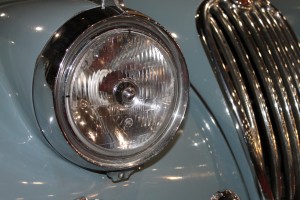 NL mark on Lucas 51507A PF 700 vertical dip
NL mark on Lucas 51507A PF 700 vertical dip
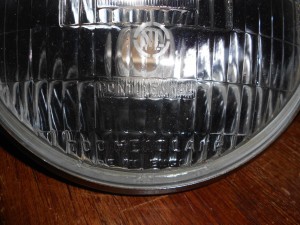 Lucas 700 Continental 553940 with NL mark
Lucas 700 Continental 553940 with NL mark
The Lucas Le Mans 24 light unit 554665 was therefore sent to KEMA in Arnhem to obtain the NL type approval and it successfully accomplished all tests. If we look at Jaguar only, this particular light unit was not only used in Holland, but in (at least) 4 other countries (Norway, Sweden, Germany, Switzerland) and we should not forget other countries like Belgium (163 XK140 and XK150 in total), Italy (47) and Portugal (18) that have not been mentioned specifically in the Spare Parts Catalogue. Lucas supplied the same light unit to other British car manufacturers so the total production of the 554665 light unit must have been several thousands.
The NL mark is the only “visible” national approval mark that we know on headlamps (apart from the later “E mark” for Europe). We should not exclude that the Dutch approval mark was accepted by other countries that had some form of cooperation with KEMA.
KEMA was (and is) a leading European (ISO certified) laboratory in the area of electrical safety and the KEMA approval mark is still found today on many electrical products. Today electrical safety schemes in Europe have a similar cooperation model (named ENEC) whereby the approval testing outcome of one member country is accepted by the other EU countries.
France also had a national homologation system for headlights for automobiles. The French Ministerial Decree of 8th October 1929 formulated new regulations for car lighting, becoming effective per 1st May 1930. According this decree all cars shall have lighting equipment that should be able to:
- Light the road over 100 metres (indicated with the letter A)
- To suppress any blinding, without ceasing to light the road, when encountering other road users (indicate with the letter B)
All headlights developed to fulfil the above requirements will be investigated by a committee of the Ministry of Public Works (Travaux Public) to receive a conformity mark mentioning e.g. Agréé AB (Certified AB). All headlights mentioning Agréé AB are followed by the letters TP (Travaux Public) and the number of the certification of the homologation (№ 123) issued by the committee.
Like the NL mark etched in the front glass for The Netherlands and Switzerland on Lucas 51565A/B headlights, the French version had a similar etched marking reading Agréé AB-TP № 457 in a dashed rectangle to show conformity to French regulations
In 1976 the new European Regulation76/761/EEC on “motor-vehicle headlamps which function as main-beam and/or dipped-beam headlamps and to incandescent electric filament lamps for such headlamps” became mandatory for all EEC member states. This replaced the various national regulations in action so far. It is also clear now that the 1976 production of the Le Mans 24 headlamps was merely aimed at replacing existing Le Mans 24 light units or for special race applications, because this (outdated) optical concept could never fulfil the newly developed requirements, nor was there a commercial interest for Lucas to do so. Therefore the need to have the NL mark on these light units was no longer there and the E mark (replacing national approval marks) was out of reach.
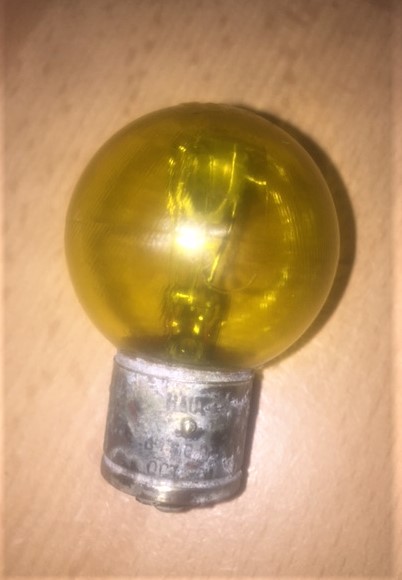
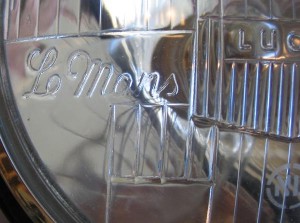
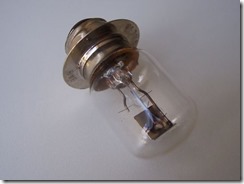
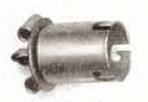
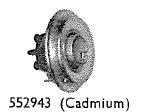
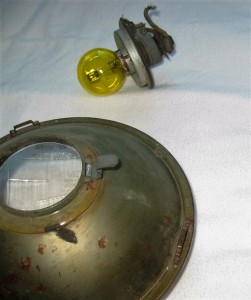
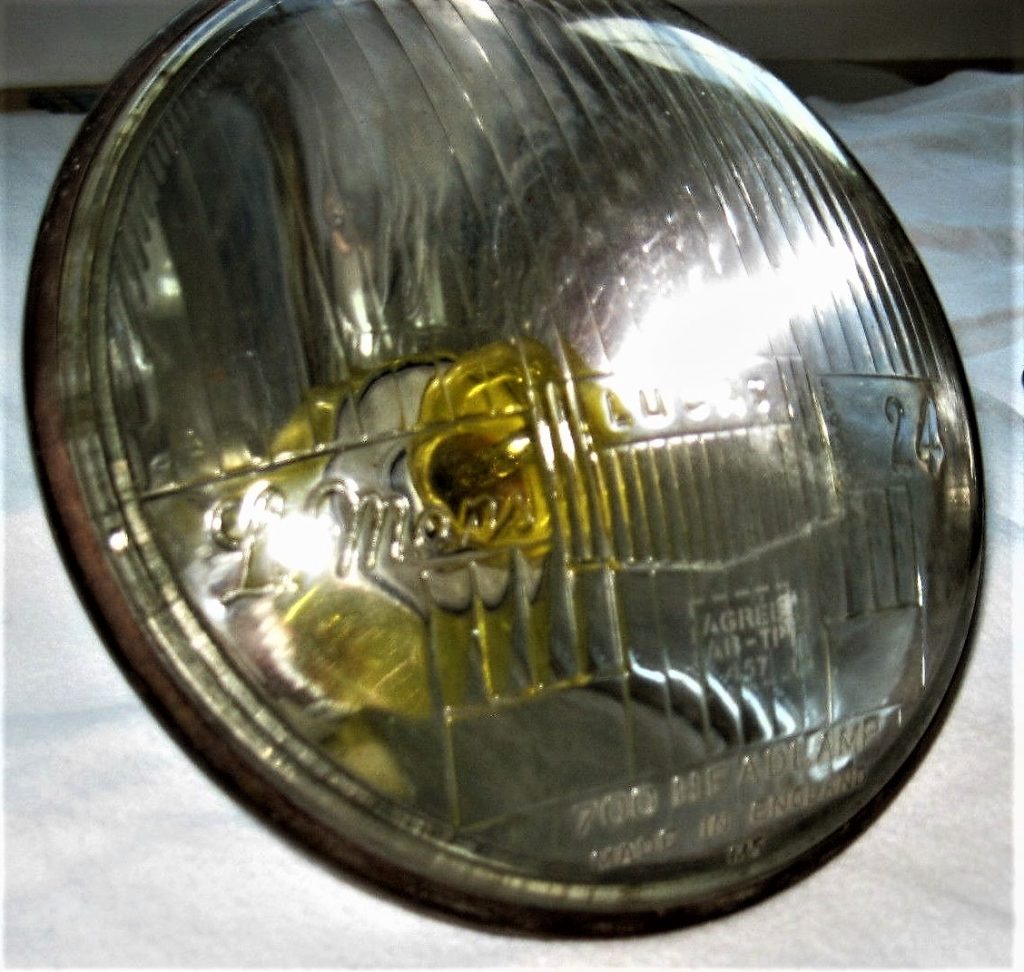
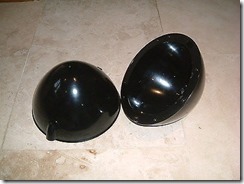
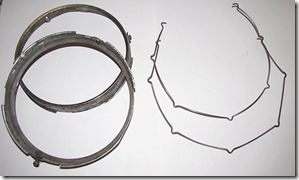
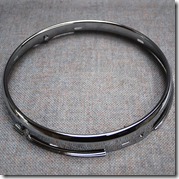
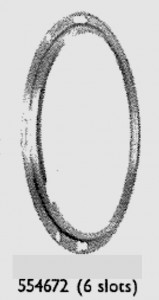
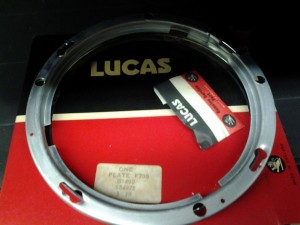
Dear Sir,
The detail you give on this Le Mans lamp unit is outstanding!
I wonder if you would allow us to use some of this on our web site with credits to you?
With best wishes,
Jeremy